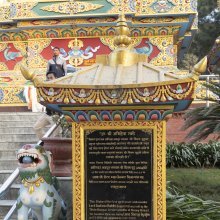Seva, Sevā, Sheva: 24 definitions
Introduction:
Seva means something in Buddhism, Pali, Hinduism, Sanskrit, the history of ancient India, Marathi, Jainism, Prakrit, Hindi, biology. If you want to know the exact meaning, history, etymology or English translation of this term then check out the descriptions on this page. Add your comment or reference to a book if you want to contribute to this summary article.
Images (photo gallery)
In Hinduism
Vaishnavism (Vaishava dharma)
Source: Pure Bhakti: Bhajana-rahasya - 2nd EditionSevā (सेवा) refers to:—Service, attendance on, reverence or devotion to. (cf. Glossary page from Bhajana-Rahasya).
Source: Pure Bhakti: Brhad BhagavatamrtamSevā (सेवा) refers to:—Service rendered with affection. (cf. Glossary page from Śrī Bṛhad-bhāgavatāmṛta).

Vaishnava (वैष्णव, vaiṣṇava) or vaishnavism (vaiṣṇavism) represents a tradition of Hinduism worshipping Vishnu as the supreme Lord. Similar to the Shaktism and Shaivism traditions, Vaishnavism also developed as an individual movement, famous for its exposition of the dashavatara (‘ten avatars of Vishnu’).
Purana and Itihasa (epic history)
Source: archive.org: Shiva Purana - English TranslationSevā (सेवा) refers to “rendering service”, according to the Śivapurāṇa 2.3.4.—Accordingly, as Umā (Durgā/Satī) spoke to the Gods:—“[...] Formerly, O gods, with great devotion Himācala and Menā rendered service [i.e., sevā] to me in my life as Sati, like my parents. Even now they continuously render me service and Menā particularly (does so). There is no doubt about my becoming their daughter. Just as you, Rudra too, desires my incarnation in the abode of Himavat. Hence I shall incarnate. That shall be the end of misery in the world. [...]”

The Purana (पुराण, purāṇas) refers to Sanskrit literature preserving ancient India’s vast cultural history, including historical legends, religious ceremonies, various arts and sciences. The eighteen mahapuranas total over 400,000 shlokas (metrical couplets) and date to at least several centuries BCE.
Jyotisha (astronomy and astrology)
Source: Wisdom Library: Brihat Samhita by VarahamihiraSevā (सेवा) refers to “service”, according to the Bṛhatsaṃhitā (chapter 15) (“On the nakṣatras—‘asterisms’”), an encyclopedic Sanskrit work written by Varāhamihira mainly focusing on the science of ancient Indian astronomy astronomy (Jyotiṣa).—Accordingly, “Those who are born on the lunar day of Punarvasu will be noted for truthfulness, generosity, cleanliness, respectable descent, personal beauty, sense, fame and wealth; they will also be merchants, dealing in excellent articles, will be fond of service (sevā-abhirata) and will delight in the company of painters and sculptors. [...]”.

Jyotisha (ज्योतिष, jyotiṣa or jyotish) refers to ‘astronomy’ or “Vedic astrology” and represents the fifth of the six Vedangas (additional sciences to be studied along with the Vedas). Jyotisha concerns itself with the study and prediction of the movements of celestial bodies, in order to calculate the auspicious time for rituals and ceremonies.
General definition (in Hinduism)
Source: Wisdom Library: HinduismSevā (सेवा) is a Sanskrit word referring to “devotional service”.
In Buddhism
Tibetan Buddhism (Vajrayana or tantric Buddhism)
Source: archive.org: The Indian Buddhist IconographySevā (सेवा, “worship”) refers to the first of the four upāyas (“means”) through which the Sādhaka has to pass before the deity is realised and visualised according to the Guhyasamāja chapter 18.—Sevā (worship) is again sub-divided into two, namely, Sāmānya (ordinary) and Uttama (excellent). Of these two, the Sāmānya-sevā consists of four Vajras: first, the conception of Śūnyatā; second, its transformation into the germ-syllable; third, its evolution in the form of a deity, and the fourth, the external representation of the deity.

Tibetan Buddhism includes schools such as Nyingma, Kadampa, Kagyu and Gelug. Their primary canon of literature is divided in two broad categories: The Kangyur, which consists of Buddha’s words, and the Tengyur, which includes commentaries from various sources. Esotericism and tantra techniques (vajrayāna) are collected indepently.
India history and geography
Source: Cologne Digital Sanskrit Dictionaries: Indian Epigraphical GlossarySevā.—cf. Tamil sevai, śervai (SITI); service; inām for services; tax-free land given to servants for enjoyment in lieu of salary. Note: sevā is defined in the “Indian epigraphical glossary” as it can be found on ancient inscriptions commonly written in Sanskrit, Prakrit or Dravidian languages.

The history of India traces the identification of countries, villages, towns and other regions of India, as well as mythology, zoology, royal dynasties, rulers, tribes, local festivities and traditions and regional languages. Ancient India enjoyed religious freedom and encourages the path of Dharma, a concept common to Buddhism, Hinduism, and Jainism.
Biology (plants and animals)
Source: Wisdom Library: Local Names of Plants and DrugsSeva in the Sanskrit language is the name of a plant identified with Malus pumila Mill. from the Rosaceae (Rose) family having the following synonyms: Malus communis, Malus domestica. For the possible medicinal usage of seva, you can check this page for potential sources and references, although be aware that any some or none of the side-effects may not be mentioned here, wether they be harmful or beneficial to health.
Source: Google Books: CRC World Dictionary (Regional names)Sheva in India is the name of a plant defined with Lonicera semenovii in various botanical sources. This page contains potential references in Ayurveda, modern medicine, and other folk traditions or local practices It has the synonym Caprifolium thomsonii Kuntze (among others).
Example references for further research on medicinal uses or toxicity (see latin names for full list):
· The Gardeners Dictionary (1754)
· Journal of the Linnean Society, Botany (1858)
· Revisio Generum Plantarum (1891)
If you are looking for specific details regarding Sheva, for example side effects, pregnancy safety, chemical composition, health benefits, diet and recipes, extract dosage, have a look at these references.

This sections includes definitions from the five kingdoms of living things: Animals, Plants, Fungi, Protists and Monera. It will include both the official binomial nomenclature (scientific names usually in Latin) as well as regional spellings and variants.
Languages of India and abroad
Pali-English dictionary
Source: BuddhaSasana: Concise Pali-English Dictionarysevā : (f.) service.
Source: Sutta: The Pali Text Society's Pali-English DictionarySevā, (f.) (fr. sev) service, resorting to S. I, 110; ThA. 179. (Page 724)

Pali is the language of the Tipiṭaka, which is the sacred canon of Theravāda Buddhism and contains much of the Buddha’s speech. Closeley related to Sanskrit, both languages are used interchangeably between religions.
Marathi-English dictionary
Source: DDSA: The Molesworth Marathi and English Dictionaryśēva (शेव).—f śēvīcēṃ jhāḍa n The name of a fruit-tree; and śēva n Its fruit.
--- OR ---
śēva (शेव).—f ī or ē A little roll of flour of pulse. 2 Toll upon garden-stuff and fruits exposed for sale.
--- OR ---
śēva (शेव).—f ē m (sīmā S) Making incisions into the tip of the pōgī of the Palm tribe in order to induce the exudation of the sap. v ghāla. 2 m Extremity, end, border, skirt (of a village, field, web, cloth): also skirts, precincts, border, vicinage. 3 fig. The bordering or connecting circumstance or particular, the link (as of a crime, of a process of tracing out, of proof or evidence). śēva ghālaṇēṃ To wave the skirt of a cloth (as in summoning from a distance). 2 To extinguish or reduce (a disease); i. e. to flap it out or down. śēva ghēṇēṃ To abate, subside, go down;--as a malady, a river, a flood. śēva dēṇēṃ or pōhañcaviṇēṃ To follow and help on a singer, to second. śēva lāvaṇēṃ To sit near unto and second or help; to lend the neighborly hand
--- OR ---
śēva (शेव).—ad Vertically or right down: opp. to karaḷa. v cāla, dhara.
--- OR ---
śēvā (शेवा).—f (Corr. from sēvā q. v.) Service &c.
--- OR ---
sēvā (सेवा).—f (S) Service, servitude, the attendance and obedience, or the office or condition, of a servant. 2 Worship or homage. 3 Service of God or of an idol; religious service. N. B. The word answers well to Divine service. 4 The use, adoption, employment, or application of a substance &c. (as detailed under sēvana).
Source: DDSA: The Aryabhusan school dictionary, Marathi-Englishśēva (शेव).—m End, skirt; the link. f A little roll of flour of pulse.
--- OR ---
sēvā (सेवा).—f Service. Worship or homage.
Marathi is an Indo-European language having over 70 million native speakers people in (predominantly) Maharashtra India. Marathi, like many other Indo-Aryan languages, evolved from early forms of Prakrit, which itself is a subset of Sanskrit, one of the most ancient languages of the world.
Sanskrit dictionary
Source: DDSA: The practical Sanskrit-English dictionaryŚeva (शेव).—[śukrapāte sati śete, śī-van Uṇādi-sūtra 1.152,154]
1) The penis.
2) A snake.
3) Height, elevation.
4) Happiness.
5) Wealth, treasure.
6) An epithet of Agni.
7) Of Soma.
-vam 1 The penis (also śevā).
2) Happiness.
3) Hail ! (exclamation addressed to deities).
Derivable forms: śevaḥ (शेवः).
--- OR ---
Seva (सेव).—See सेवन, सेवि (sevana, sevi) (2).
--- OR ---
Sevā (सेवा).—[sev-a]
1) Service, servitude, dependence; attendance; सेवां लाघवकारिणीं कृतधियः स्थाने श्ववृत्तिं विदुः (sevāṃ lāghavakāriṇīṃ kṛtadhiyaḥ sthāne śvavṛttiṃ viduḥ) Mu. 3.14; हीनसेवा न कर्तव्या (hīnasevā na kartavyā) H.3.11.
2) Worship, homage, honouring.
3) Addiction or devotion to, fondness for.
4) Use, practice, employment, exercise.
5) Frequenting, resorting to.
6) Flattery, coaxing or flattering words; अलं सेवया मध्यस्थतां गृहीत्वा भण (alaṃ sevayā madhyasthatāṃ gṛhītvā bhaṇa) M.3.
Source: Cologne Digital Sanskrit Dictionaries: Shabda-Sagara Sanskrit-English DictionaryŚeva (शेव).—m.
(-vaḥ) 1. The penis. 2. A snake. 3. Heighth, elevation. 4. Happiness. n.
(-vaṃ) 1. The penis. 2. Happiness. Ind. (-vam) Hail, homage, a term of exclamation or salutation addressed to the deities. E. śīṅ to sleep, Unadi aff. van .
--- OR ---
Sevā (सेवा).—f.
(-vā) 1. Service, servitude. 2. Worship, homage. 3. Addition to. 4. Use, practise, employment. 5. Resorting to, frequenting. E. ṣev to serve, affs. aṅ and ṭāp .
Source: Cologne Digital Sanskrit Dictionaries: Benfey Sanskrit-English DictionaryŚeva (शेव).—I. m. 1. A snake (vb. śī) 2. Happiness. Ii. acc. vam, indecl. Hail, homage, an exclamation or salutation addressed to the deities. Iii. n., and f. vā, The penis (cf. śepa).
--- OR ---
Sevā (सेवा).—[sev + ā], f. 1. Service, [Mānavadharmaśāstra] 4, 5; [Vikramorvaśī, (ed. Bollensen.)] [distich] 42. 2. Servitude, [Hitopadeśa] i. [distich] 136, M. M. 3. Practice, [Rājataraṅgiṇī] 5, 280. 4. Worship, [Bhagavadgītā, (ed. Schlegel.)] 4, 34. 5. Homage, [Rājataraṅgiṇī] 5, 154.
Source: Cologne Digital Sanskrit Dictionaries: Cappeller Sanskrit-English DictionaryŚeva (शेव).—[adjective] kind, dear.
--- OR ---
Sevā (सेवा).—[feminine] visit, service, attendance, worship, devotion to, use, practice, employment; sexual intercourse with ([genetive] or —°).
Source: Cologne Digital Sanskrit Dictionaries: Monier-Williams Sanskrit-English Dictionary1) Śeva (शेव):—mfn. ([probably] [from] √śvi, and connected with śavas and śiva) dear, precious, [Ṛg-veda; Atharva-veda]
2) m. (only [cf. Lexicographers, esp. such as amarasiṃha, halāyudha, hemacandra, etc.]) the male organ (cf. śepa)
3) a serpent
4) a fish
5) height, elevation
6) treasure, wealth
7) Name of Agni
8) Śevā (शेवा):—[from śeva] f. the form of the Liṅga, [cf. Lexicographers, esp. such as amarasiṃha, halāyudha, hemacandra, etc.]
9) Śeva (शेव):—n. prosperity, happiness, [Horace H. Wilson]
10) hail, homage (an exclamation or salutation addressed to the deities), [ib.]
11) Seva (सेव):—[from sev] n. (either [from] √sev or siv) [gana] pacādi = sevi1, an apple, [cf. Lexicographers, esp. such as amarasiṃha, halāyudha, hemacandra, etc.]
12) Sevā (सेवा):—[from sev] f. going or resorting to, visiting, frequenting, [Cāṇakya; Subhāṣitāvali]
13) [v.s. ...] service, attendance on ([locative case] [genitive case], or [compound]; sevāṃ-√kṛ, with [genitive case], ‘to be in the service of’), [Manu-smṛti; Mahābhārata] etc.
14) [v.s. ...] worship, homage, reverence, devotion to ([genitive case] or [compound]), [ib.]
15) [v.s. ...] sexual intercourse with ([compound]), [Hitopadeśa; Subhāṣitāvali]
16) [v.s. ...] addiction to, indulgence in, practice or employment or frequent enjoyment of ([compound]), [Nirukta, by Yāska; Manu-smṛti; Mahābhārata etc.]
Source: Cologne Digital Sanskrit Dictionaries: Yates Sanskrit-English Dictionary1) Śeva (शेव):—(vaḥ) 1. m. The penis; a snake; height; happiness. adv. Hail!
2) Seva (सेव):—(ṛ, ṅa) sevate 1. d. To serve.
3) Sevā (सेवा):—(vā) 1. f. Service, worship.
Source: DDSA: Paia-sadda-mahannavo; a comprehensive Prakrit Hindi dictionary (S)Sevā (सेवा) in the Sanskrit language is related to the Prakrit word: Sevā.
[Sanskrit to German]
Sanskrit, also spelled संस्कृतम् (saṃskṛtam), is an ancient language of India commonly seen as the grandmother of the Indo-European language family (even English!). Closely allied with Prakrit and Pali, Sanskrit is more exhaustive in both grammar and terms and has the most extensive collection of literature in the world, greatly surpassing its sister-languages Greek and Latin.
Hindi dictionary
Source: DDSA: A practical Hindi-English dictionary1) Seva (सेव) [Also spelled sev]:—(nm) an apple; a saltish/sweet vermicelli-like preparation of gram flour.
2) Sevā (सेवा):—(nf) service; attendance; -[kāla] tenure of service; -[ṭahala] servitude, service; ~[dāra] attendant; ~[dārī] attendance; ~[nivṛtta] retired; ~[nivṛtti] retirement; -[vṛtti] service; —[karanā] to serve; to attend on.
...
Prakrit-English dictionary
Source: DDSA: Paia-sadda-mahannavo; a comprehensive Prakrit Hindi dictionary1) Seva (सेव) in the Prakrit language is related to the Sanskrit word: Sev.
2) Sevā (सेवा) also relates to the Sanskrit word: Sevā.
Prakrit is an ancient language closely associated with both Pali and Sanskrit. Jain literature is often composed in this language or sub-dialects, such as the Agamas and their commentaries which are written in Ardhamagadhi and Maharashtri Prakrit. The earliest extant texts can be dated to as early as the 4th century BCE although core portions might be older.
Kannada-English dictionary
Source: Alar: Kannada-English corpusŚēva (ಶೇವ):—
1) [noun] = ಶೇಫ - [shepha -] 1.
2) [noun] a snake or serpent.
3) [noun] height; elevation.
4) [noun] joy; happiness.
5) [noun] fire.
6) [noun] riches; wealth.
7) [noun] the juice of the plant Sarcostemma acidum ( = S. brevistigma) of Asclepiadaceae family.
--- OR ---
Sēva (ಸೇವ):—[noun] the quality or condition of being safe and happy; freedom from danger, injury, sickness or damage; security; safety; welfare.
Kannada is a Dravidian language (as opposed to the Indo-European language family) mainly spoken in the southwestern region of India.
See also (Relevant definitions)
Starts with (+137): Ceva, Cevai, Cevainali, Cevakakkacu, Cevakam, Cevakamelutu, Cevakan, Cevakanar, Cevakanarkilanku, Cevakappatam, Cevakavirutti, Ceval, Cevalal, Cevalam, Cevalan, Cevalikam, Cevalkattal, Cevam, Cevamaram, Cevanai.
Ends with (+67): Adhiseva, Agniseva, Anuseva, Asheva, Ashtakaliyaseva, Atiseva, Atithiseva, Audyogika-seva, Avakamaseva, Bahya-seva, Bajaraseva, Basaseva, Bhavaseva, Caranaseva, Ceva, Charanaseva, Dirghaseva, Duhsheva, Durasancaraseva, Duraseva.
Full-text (+163): Atithiseva, Asheva, Dvitseva, Striseva, Hinaseva, Sevadhi, Shevas, Vriddhaseva, Caranaseva, Yogaseva, Varaseva, Shevara, Sevi, Bahya-seva, Sainik-seva, Bahiroba, Shev, Praseva, Paraseva, Patiseva.
Relevant text
Search found 43 books and stories containing Seva, Sevā, Śēva, Śeva, Śēvā, Śevā, Sēvā, Sēva, Sheva; (plurals include: Sevas, Sevās, Śēvas, Śevas, Śēvās, Śevās, Sēvās, Sēvas, Shevas). You can also click to the full overview containing English textual excerpts. Below are direct links for the most relevant articles:
Garga Samhita (English) (by Danavir Goswami)
Verse 5.9.13 < [Chapter 9 - The Happiness of the Yadus]
Verse 1.11.65 < [Chapter 11 - Description of Śrī Kṛṣṇacandra’s Birth]
Verse 3.1.24 < [Chapter 1 - The Worship of Śrī Girirāja]
Rig Veda (translation and commentary) (by H. H. Wilson)
Brihad Bhagavatamrita (commentary) (by Śrī Śrīmad Bhaktivedānta Nārāyana Gosvāmī Mahārāja)
Verse 2.4.98 < [Chapter 4 - Vaikuṇṭha (the spiritual world)]
Verse 2.1.201 < [Chapter 1 - Vairāgya (renunciation)]
Verse 2.4.191 < [Chapter 4 - Vaikuṇṭha (the spiritual world)]
Bhakti-rasamrta-sindhu (by Śrīla Rūpa Gosvāmī)
Verse 1.2.118 < [Part 2 - Devotional Service in Practice (sādhana-bhakti)]
Verse 2.5.90 < [Part 5 - Permanent Ecstatic Mood (sthāyī-bhāva)]
Verse 3.3.44 < [Part 3 - Fraternal Devotion (sakhya-rasa)]
Prasthanatrayi Swaminarayan Bhashyam (Study) (by Sadhu Gyanananddas)
8.2. Significance of Sevā (service) < [Chapter 4 - Analysis on the Basis of Spiritual Endeavour]
8. Physical Sādhanā (Introduction) < [Chapter 4 - Analysis on the Basis of Spiritual Endeavour]
5.4. Classification of Ultimate Pramā < [Chapter 2 - Analysis on the Basis Of Epistemology]
Related products
(+1 more products available)







